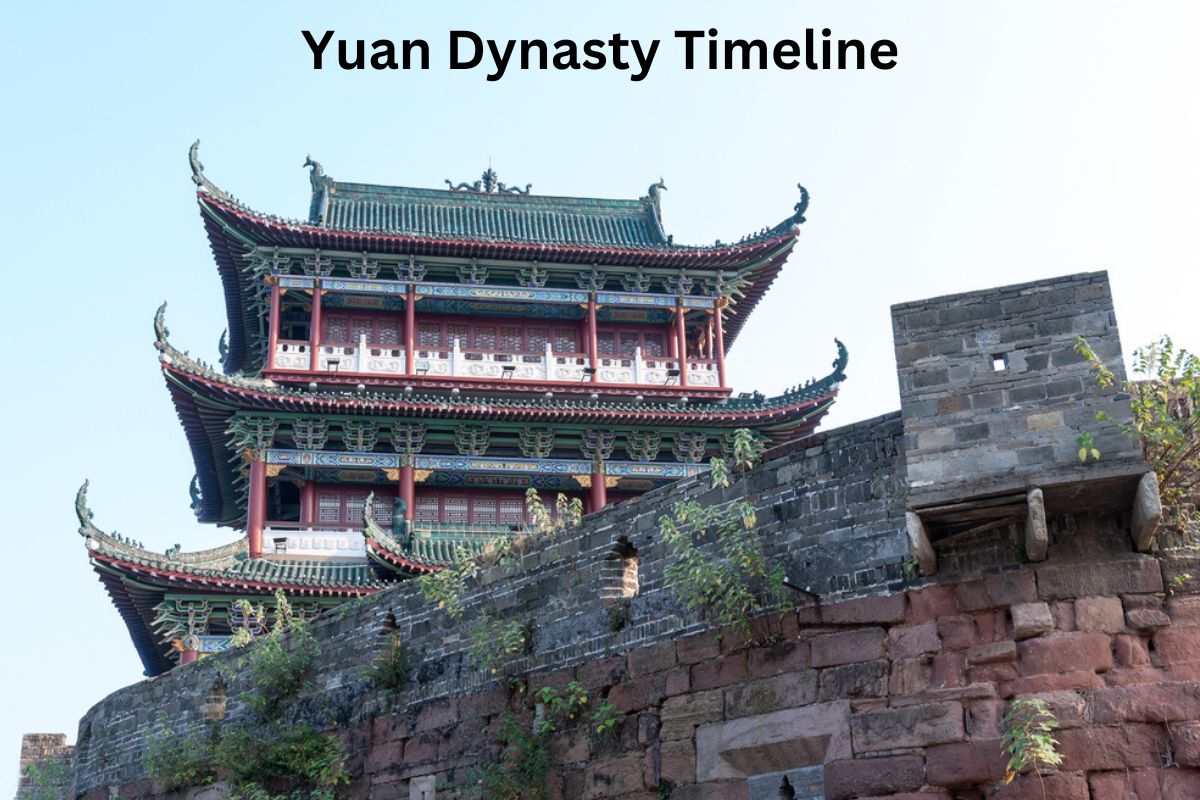The Yuan Dynasty, spanning from 1271 to 1368, was a pivotal era in China’s history. Founded by Kublai Khan, a descendant of Genghis Khan, it marked the first time a non-Chinese ruler governed China.
This dynasty’s reign witnessed both grand achievements and significant challenges, from its successful conquests that unified China under Mongol rule, to failed invasions of Japan and internal struggles that ultimately led to its downfall.
The Yuan Dynasty’s influence extended beyond its borders, with the likes of Marco Polo documenting its unique culture.
In 1368, the dynasty was replaced by the Ming Dynasty, bringing an end to foreign domination and shaping China’s trajectory anew.
| Year | Event |
|---|---|
| 1206 | Genghis Khan unifies Mongol tribes. |
| 1215 | Mongols conquer Jin Dynasty. |
| 1271 | Yuan Dynasty founded by Kublai Khan. |
| 1279 | Yuan Dynasty conquers Southern Song Dynasty. |
| 1281 | Failed Mongol invasions of Japan. |
| 1295 | Marco Polo arrives at Yuan court. |
| 1307 | Kublai Khan dies, dynasty faces decline. |
| 1315-1320 | Famine strikes northern China. |
| 1368 | Yuan Dynasty overthrown, Ming Dynasty begins. |
Timeline of the Yuan Dynasty
1206 – Genghis Khan unifies Mongol tribes
In the year 1206, Genghis Khan, a charismatic and skilled leader, successfully united the various Mongol tribes under his leadership. This marked the foundation of the Mongol Empire, a vast and powerful entity that would shape the course of history.
Also Read: Facts About the Yuan Dynasty
Genghis Khan’s military campaigns and innovative tactics helped him conquer neighboring territories, laying the groundwork for the expansion of Mongol influence.
1215 – Mongols conquer Jin Dynasty
In 1215, the Mongols, led by Genghis Khan’s forces, conquered the Jin Dynasty, which ruled over northern China. This marked a significant step in the Mongols’ expansion into Chinese territories and provided them with greater access to resources and manpower.
Also Read: Ming Dynasty Facts
The Jin Dynasty’s fall allowed the Mongols to establish a foothold in the region, setting the stage for further conquests.
1271 – Yuan Dynasty founded by Kublai Khan
In 1271, Kublai Khan, a grandson of Genghis Khan, officially established the Yuan Dynasty. He had been a powerful figure within the Mongol Empire and successfully consolidated his rule over China after a period of conflict and negotiation.
Also Read: Accomplishments of the Yuan Dynasty
Kublai Khan adopted a policy of Sinicization, blending Mongol traditions with Chinese administrative practices, and moved the capital to Khanbaliq, which is now known as Beijing.
This marked the beginning of a new era in Chinese history, with non-Chinese rulers in charge of the country for the first time.
1279 – Yuan Dynasty conquers Southern Song Dynasty
In 1279, the Yuan Dynasty achieved a significant victory by conquering the Southern Song Dynasty.
This marked the completion of the Mongols’ conquest of the entire Chinese territory, reuniting the northern and southern regions under a single ruler for the first time in centuries.
The fall of the Southern Song Dynasty marked the end of a tumultuous period of division and war within China and solidified the Yuan Dynasty’s control over the entire country.
1281 – Failed Mongol invasions of Japan
In 1281, the Yuan Dynasty, under the leadership of Kublai Khan, launched two unsuccessful invasions of Japan. These invasions, known as the Mongol Invasions of Japan or the “Kamikaze” (divine wind) invasions, aimed to bring Japan under Mongol control.
However, both attempts were thwarted by a combination of fierce Japanese resistance, strategic defenses, and timely typhoon storms that severely damaged the Mongol fleets.
These failed invasions marked a significant setback for the Yuan Dynasty’s expansionist ambitions and contributed to the maintenance of Japan’s independence.
1295 – Marco Polo arrives at Yuan court
In 1295, the Venetian explorer Marco Polo arrived at the Yuan Dynasty’s court in China. He spent around 17 years in various parts of China, serving in different administrative roles under Kublai Khan.
Marco Polo’s written accounts of his travels, known as “The Travels of Marco Polo,” provided valuable insights into the culture, society, and geography of the Yuan Dynasty and other regions he visited. His writings played a crucial role in introducing China and its wonders to the Western world.
1307 – Kublai Khan dies, dynasty faces decline
In 1307, Kublai Khan, the founder of the Yuan Dynasty, passed away. His death marked a turning point in the dynasty’s history, as subsequent rulers struggled to maintain the same level of authority and control that Kublai Khan had achieved.
The Yuan Dynasty began to experience internal strife, financial difficulties, and challenges to its rule from various groups within China. This period of decline weakened the dynasty’s hold on power and set the stage for further unrest.
1315-1320 – Famine strikes northern China
Between 1315 and 1320, northern China faced a severe famine caused by a combination of factors, including adverse weather conditions, crop failures, and inadequate government responses.
The famine resulted in widespread suffering, starvation, and death. The Yuan Dynasty’s inability to effectively address the crisis further eroded its legitimacy and led to social unrest and discontent among the population.
1368 – Yuan Dynasty overthrown, Ming Dynasty begins
In 1368, after decades of internal strife, popular uprisings, and the weakening of Yuan rule, the Mongol-led Yuan Dynasty was overthrown by a rebellion led by Zhu Yuanzhang, who later became Emperor Hongwu.
Zhu’s forces captured Khanbaliq (Beijing) and established the Ming Dynasty, signaling the end of Mongol rule in China.
The Ming Dynasty sought to restore traditional Chinese governance and cultural practices, and its founding marked a new era in Chinese history after the Yuan Dynasty’s foreign rule.
